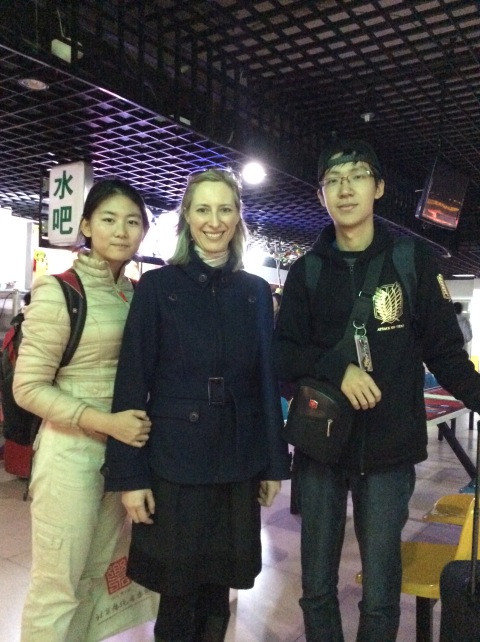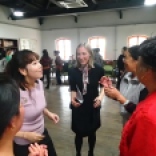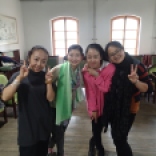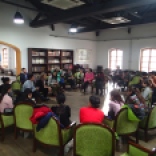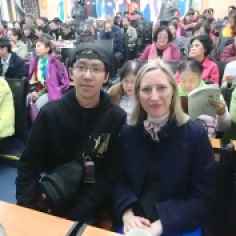Archive for the ‘keynote’ Tag
Trends in community music research
I recently gave a keynote presentation in Beijing as part of the Third Community Music Education Summit Forum, hosted by the China Conservatory. I was asked to speak about current trends in community music research, which was an interesting question to grapple with.
I began by reviewing proceedings from a number of conferences over the last three years, and back issues of the International Journal of Community Music. I also thought about discussions I’d been part of with colleagues here in Australia and overseas. In the end I came up with this list:
Historical mapping of community music activities in countries and regions
It seems to me that in the absence of a neat universal definition of what constitutes community music (and I’m not saying there should be one – just observing its absence and the perennial discussion of “what is community music” that recurs periodically as a result) these kinds of historical overviews that dig into region/country-specific political-economic-social environments, shifts, changes, and trends are becoming increasingly useful documents. Lee Higgins wrote one that for me is definitive of the style, examining the historical context of community music development in the UK; Andy Krikun has written some fascinating accounts of the development of community banding in the United States; Roger Mantie has examined some of the historical shifts (albeit the a focus on language and discourse in key journals) of the wind band scene in Canada. Shorter overviews of other countries’ contexts for current practice were included in ‘Community Music Today’ (Veblen, Elliott, and Messenger, 2012). I’m hopefully the trend will expand further, and that we’ll see similar studies emerging from regions that are less-represented in the community music literature thus far.
Typologies and conceptual frameworks
Related to these alternatives to a universal definition is a continued effort to offer frameworks or conceptual models for understanding community music activity. These turn up fairly frequently, and depending on what is being examined, offer varying degrees of usefulness (which means it is useful to have multiple options). Huib Schippers unveiled a very interesting set of three domains of community music at the recent Asia-Pacific Community Music Network meeting that draws upon his extensive work on music sustainability and eco-systems. The ecological perspective illuminates different aspects of music activities and projects – for example, providing a tool for understanding the community expectations of a community music intervention, which may differ from the expectations of its organizers.
Online community music communities
There’s a growing number of really interesting studies that explore this topic from different angles – pedagogy and informal learning, communities of practice, materials, different applications of technologies, as a participatory cultural practice, limitations and possibilities, and so on. The International Journal of Community Music devoted a recent Special Edition to this topic.
El Sistema and Sistema-inspired activities
I’ve also observed a growing presence for Sistema-inspired programs in community music research. The twin goals of social care and music learning, and the complex contexts in which these projects work make these activities a good match with community music research. At present, research on this topic may still be more frequently directed toward pure music education forums, however, I’m anticipating a continued gradual positioning of this research in the community music sphere. What’s more, the next group of PhD scholars and researchers interested in examining a Sistema-inspired project can read an inspired/inspiring list of potential research questions in Roberta Lamb’s review of Geoff Baker’s ‘El Sistema – Orchestrating Venezuela’s Youth’. See pp. 178-179, here.
I closed the keynote presentation with a series of ‘hot tips’ – topics that I predict will emerge as future trends in the next 3-5 years:
- Gender in community music. It hasn’t come in for much attention thus far, but it’s an important area for examination. Music is an extremely gendered practice; the paper “From snuggling and snogging to sampling and scratching: Girls’ non-participation in community-based music activities” (Baker, Sarah, & Cohen, Bruce M. Z, 2008) is well-worth a read for an initial examination to how this can play out in community-based music activities.
- Pushback against the ‘intervention’ model as the gold standard towards more organic, community-driven music approaches. I predict this will come about as non-English language community music work gains profile in the research literature. The relevance of this difference in emphasis of what practices look like and deliver was particularly evident at this year’s Asia-Pacific Community Music Network gathering (Japan, July 2015); indeed, the increasing ‘pushback’ was a topic that was discussed in the closing comments of that conference.
- Happiness and Joy. I predict that as researchers we will begin to look beyond the instrumentalised focus of many community music activities (or of their organisers’) to put the spotlight more firmly on participant experience, which will foreground some of community music’s least measurable, most subjective outputs – such as experiences of happiness and joy.
- Street bands and music-as-activism. I predict we will see an increase in the visibility of these kinds responses to social issues, and consequently they will begin to feature more prominently in community music research. The activities are not new, but I predict a revived interest in the dynamics of this kind of music-making as it interacts with local and global contexts for change and citizen action.
What do you think? Are there trends in community music research that you’ve observed that could be included here? What are your own tips for the next ‘hot topics’ in community music research?
Return to China
I loved this return visit to Beijing. It’s always nice to be hosted, and the Chinese are wonderful hosts! My plane touched down at 3am, and when I finally emerged through the gates into the public area (that airport is enormous, it took me ages to walk through given I was still recovering from my recent surgeries), two very tired but smiling student volunteers from the China Conservatory were there to meet me.
My first day was free of work tasks so one of the volunteers took me to the Panjiayuan antiques market where traders from different parts of China were selling antiques (some real, some less real) and handcrafts. I bought some gifts for family, friends and friends’ children, but mostly just loved the browsing and people-watching.
We also went to Beijing Glasses City. This is a mall filled with spectacle-sellers, lens-grinders, and optical accessories stalls. My student guide, Wang (although I later suggested an English name for him – Max – which he loved and immediately adopted) is from the Xinjiang Autonomous Region, up in the north-west, sharing the border with Kazakhstan and Kyrgystan, so Beijing Glasses City was a new discovery for him. I chose frames and got my eyes tested and had new glasses made within 30 minutes.
The next day I led a music workshop for community music and dance teachers from around China, who were in town for the Community Music Education Summit Forum (I love that the event was both a summit and a forum). We did a range of collaborative composition tasks, using voices and body percussion. They were a great group. Though, I was reminded how tricky it can be to work with an interpreter in composition tasks. Sometimes, the pace of the work moves very quickly and I want to be able to give a key direction or piece of information in a very specific moment. It’s tricky to remember that if I just speak when I want to speak, the group won’t understand what I’m saying, and the energy behind it can translate as stressful urgency, rather than just in-the-moment encouragement that progresses the composition along in a critical point in time. A couple of times I really had to bite my tongue to give the interpreter a chance to move across the room to me and translate my instruction for the group.
That evening, Max and I found a Xin Jiang restaurant where we ordered too much and had a fantastic meal of very Central Asian food. Max took the leftovers back to the dormitory for his room-mates. I was pretty excited to discover this new cuisine, although I also realized it was similar to I had had at the Uyghur restaurants in Kazakhstan. I fell in love with the sturdy wooden kebab sticks they served our meat on, and the wooden spoons that they served our yoghurt with. Max asked the waitress if I could buy them. She said no.
My last day in Beijing was the day of my keynote presentation. We travelled together to the conference venue (a community college). There were a number of formalities at the start of the day, and I joined the group of presenters on the stage for many of these. My presentation was well-received by the group and afterwards I had the chance to speak with a number of community music educators. One told me she was delighted that I had spoken about the importance of acknowledging happiness and joy in community music. “That’s what it is all about,” she stated emphatically.
In the afternoon, the student volunteers took me to see the China Conservatory. They walked me through the grounds, showing the impressive practice annex, and the student dormitories where they both lived. We had tea together in a small Xinjiang café in their basement student food hall. I fell in love with the beautiful teapot they served our green tea in and wanted to buy it. This time I didn’t ask though. It isn’t quite right to offer to buy the serving paraphernalia in every restaurant you go to, is it? Max had brought me some Xinjiang snacks, which consisted of extremely hard round crispy breads, which he called naan. They were so hard I wondered if I might break a tooth. It felt a bit like trying to eat an enormous rusk.
Then the time came for me to head to the airport, and both Max and Heidi (the second student volunteer) accompanied me there. They helped me with the check-in, organizing for me to have some assistance getting to the gate so that I wouldn’t have to carry my bag too far in my post-surgery state. Heidi had been the main person I’d communicated with prior to my departure and she knew I’d been ill, so was particularly concerned to take care of me.
They both sent me text messages wishing me well in the couple of hours between our farewell and my take-off. They were the sweetest volunteer helpers ever! Thank you Max and Heidi for making this visit to China so delightful!
 Leave a comment
Leave a comment
